History - Class 10
Our Past - I
Chapter 2: Nationalism in India
Activity: 1
Question: Read the text carefully. What did Mahatma Gandhi mean when he said Satyagraha is active resistance?
Answer:
- Satyagraha does not mean to inflict pain on the adversary rather it is the source of soul.
- Truth is the substance of soul and so it is the substance of Satyagraha.
- It does not mean destruction but it means to clear the minds of adversaries and convert destructive thoughts into constructive by showing them love, compassion and truth.
Activity: 2
Question: The year is 1921. You are a student in a government-controlled school. Design a poster urging school students to answer Gandhiji,s call to join the Non-Cooperation Movement.
Answer:
Wake up call Throw the British rule in 1921!
Dear students,
Our Motherland India is suffering badly at the hands of Britishers, who are exploiting our countrymen socially and economically.
Join your hands with our beloved Bapu and immediately stop cooperating with the British government.
The success of the non cooperation movement depends on you.Activity: 3
Question: If you were a peasant in Uttar Pradesh in 1920, how would you have responded to Gandhiji’s call for Swaraj? Give reasons for your response.
Answer: I would have responded to Gandhiji call for swaraj in a positive non – violent manner. His way of truth and non- violence was the most potent way to attain swaraj, therefore, I would have followed him.
Activity: 4
Question: Find out about other participants in the National Movement who were captured and put to death by the British. Can you think of a similar example from the national movement in Indo-China (Chapter 2)?
Answer: There were many participants in the National Movement who were captured and put to death or otherwise killed by the British. These included Bhagat Singh, Sukhdev, Rajguru, Chandrashekhar Azad, Lala Lajpat Rai, Khudiram Bose and Madan Lal Dhingra.
Discuss: 1
Question: Why did various classes and groups of Indians participate in the Civil Disobedience Movement?
Answer: The various classes and groups of Indian participated in the Civil Disobedience Movement due to their own, limited motives. To them “swaraj” meant something they carvedfor.
For example:
- To businessmen, swaraj meant a time when colonial restrictions on business would no longer exist and trade and industry would flourish without constraints.
- Similarly to rich peasant classes, swaraj was a struggle against high land revenue.
- Women took swaraj as the attainment of elevated status and equality with men in Indian society.
- Poor peasants considered swaraj as the time when they would have their own land, would not have to pay rents or do beggar.
- Working class dreamed for high wages and excellent working conditions.
Discuss: 2
Question: Read the Source D carefully. Do you agree with Iqbal’s idea of communalism? Can you define communalism in a different way?
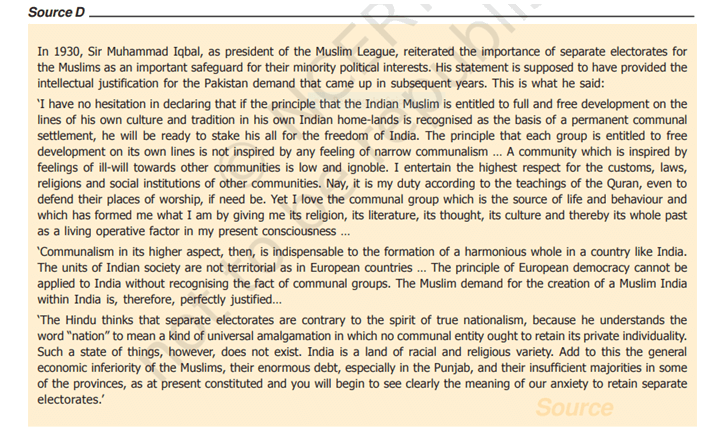
Answer:
- No, I do not agree with Iqbal’s idea of communalism as it was based upon the thought that India is a land of racial and religious variety.
- That does not really mean that India needed any type of communal settlement or division on the basis of community.
- According to me, communalism believes in the government of a specific community. It does not have any element of nation in it, which was the motive of nationalist struggle for India’s freedom.
Activity: 5
Question: Look at Figs. 12 and 14. Do you think these images will appeal to all castes and communities? Explain your views briefly.
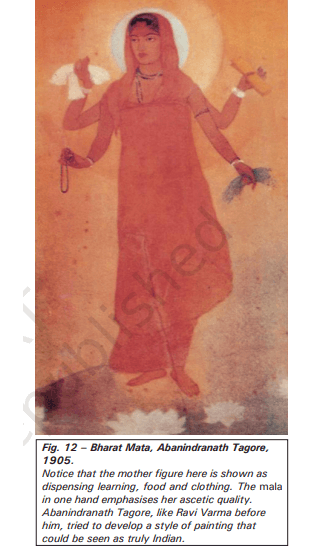
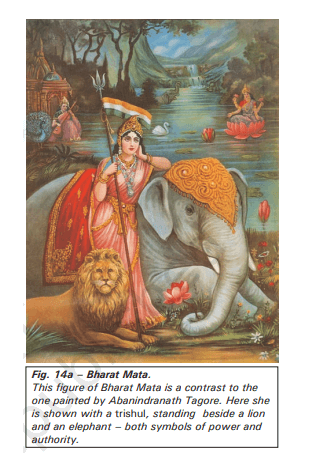
Answer:
- No, I do not think that these images would appeal to all castes and communities of India.
- Because, these images of “Bharat Mata” show her in the incarnation of a Hindu Goddess.
- This gives a religious biasness to the image. It should be avoided. The image should reflect the nationalist idea of unity of all castes and communities.
Write in brief
Question 1. Explain:
- Why the growth of nationalism in the colonies is linked to an anti-colonial movement?
- How the First World War helped in the growth of the National Movement in India?
- Why Indians were outraged by the Rowlatt Act?
- Why Gandhiji decided to withdraw this Non-Cooperation Movement?
Answer:
- Why the growth of nationalism in the colonies is linked to an anti-colonial movement?
- In India, as in Vietnam and many other colonies, the growth of modem nationalism is intimately connected to the Anti-colonial Movement. People began discovering their unity in the process of their struggle with colonialism. The sense of being oppressed under colonialism provided a shared bond that tied many different groups together.
- The European powers considered their culture more civilized, modern, and superior. They forcefully started imposing their culture on the colonies. This also aroused the feeling of nationalism.
- Gandhiji used ‘Satyagraha’ against the Britishers. This also promoted the spirit of nationalism among the people.
- The anti-colonial movement was a united struggle by the people against foreigners. The united struggle was responsible for arousing the spirit of nationalism.
- The War created a new economic and political situation:
- It led to a huge increase in defence expenditure which was financed by war loans and increasing taxes, customs duties were raised, and income tax introduced.
- Through the war years, prices increased – doubling between 1913 and 1918 – leading to extreme hardships for the common people.
- Villagers were called upon to supply soldiers, and forced recruitment in rural areas caused widespread anger.
- Why Indians were outraged by the Rowlatt Act?
- Rowlatt Act was passed through the Imperial Legislative Council on a report of the Sedition Committee, headed by Justice Rowlatt.
- It was the black act which gave the government and the police to repress political activities and allowed detention of political prisoners without tried for two years..
- The Act was passed despite the united opposition of the Indian members of the Council.
This Act became one of the factors due to which Gandhiji launched the Non-Cooperation Movement.
- Why Gandhiji decided to withdraw this Non-Cooperation Movement?
In February 1922, Gandhiji decided to withdraw the Non-Cooperation Movement due to the following reasons:
- The movement was turning violent. At Chauri-Chaura in Gorakhpur, a peaceful demonstration in a Bazar turned into a violent clash in which more than 20 policemen were killed.
- Gandhiji felt that the Safyagrahis needed to be properly trained before they would be ready for mass struggle.
- Within the Congress, some leaders were tired of mass struggles and wanted to participate in elections to the provincial councils, which were set up under the Government of India Act, 1919.
- Industrialists, workers, peasants etc. interpreted the term ‘Swaraj’ in their own way. At many places like that of Andhra Pradesh, leaders like Alluri Sitaram Raju asserted that India could be liberated only by the use of force. But their values were not approved by the Congress.
Question 2. What is meant by the idea of Satyagraha?
Answer:
- It was a non-violent method of mass agitation against the Oppressor.
- It emphasized the power of truth and the need to search the truth.
- It suggested that if the cause was true if the struggle was against injustice, there is no need for physical force to fight the oppressor.
- People-including the oppressors had to be persuaded to see the truth instead of being forced to accept truth through the use of violence.
- By this struggle, the truth was bound to be victorious.
Question 3. Write a newspaper report on
- The Jallianwalla Bagh massacre
- The Simon Commission
Answer:
- The Jallianwalla Bagh massacre
- The Simon Commission
Amritsar
13 April 1919
Today is Baisakhi day. The people of Punjab celebrate this day with pomp and show. The festival commemorates the establishment of the Khalsa panth or Sikh order by tenth Sikh Guru, Gobind Singh on Baisakhi Day on April 13, 1699. It also marks the start of the harvest season in Punjab and Haryana.Today to celebrate Baisakhi a large crowd of non-violent protesters against the policy of the government along with pilgrims gathered in Jallianwala Bagh. There were thousands of men, women and children. People had come from the villages around Amritsar. It was a peaceful gathering and people were enjoying the festival.
General Dyer had imposed Martial Law in the city. However, it was not announced properly. People who had come from outside did not know about it.The Bagh-space comprised 6 to 7 acres and was walled on all sides. General Dyer could not tolerate the gathering. He came with his troops and ordered them to fire on the crowd for ten minutes directing their bullets largely towards the gates through which people were trying to flee.
The firing went on till the ammunition was exhausted. After the massacre, the wounded were left without medical help. The exact number of casualities is not known. It included people of all ages i.e., children, women, young and old. It is injustice with the people of Punjab.New Delhi,
15 January 1928
The new Tory government in Britain has appointed a Statutory Commission under Sir John Simon in response to the nationalist movement in India. The Commission will look into the functioning of the constitutional system in India and suggest changes. It is really strange that though object of the commission is to look into an -indian problem but no Indian has been appointed as its member.All the members were Britishers. This is gross injustice. Indians must raise their voice against it and resist the Commission at all levels so that the British government may include Indians in the Commission.
Question 4. Compare the images of Bharat Mata in this chapter with the image of Germania in Chapter I?


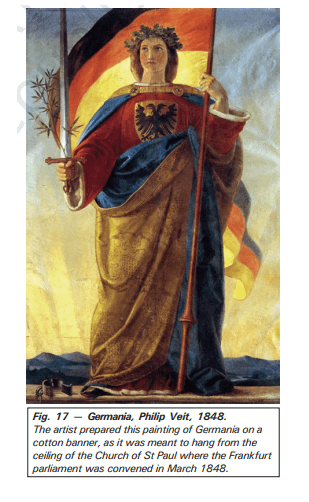
Answer: There are two images of Bharat Mata one by Abanindranath Tagore and the second by another artist. In the image by Tagore, Bharat Mata is portrayed as an ascetic figure. She has been shown as calm, composed, divine and spiritual. She is shown also as dispensing learning food and clothing. Abanindranath Tagore tried to develop a style of painting that could be seen as truly Indian.
In the second figure, Bharat Mata is shown with a trishul, standing beside a lion and an elephant both symbols of power and authority. This figure is a contrast to the one painted by Abanindranath Tagore.
On the other hand, the image of Germania by Philip Veet wears a crown of oak leaves which stands for heroism. Thus, there is one similarity between Bharat Mata and Germania – both have an element of bravery i.e., power, authority, and heroism.Discuss
Question 1. List all the different social groups which joined the Non-Cooperation Movement of 1921. Then choose any three and write about their hopes and struggles to show why they joined the movement.
Answer: The social groups of India that joined the Non- Cooperation Movement of 1921 were as under:
- Middle – classes people (students, headmasters, teachers, lawyers, etc.)
- Political parties, except the Justice Party of Madras, the party of non-Brahmins.
- Merchants and traders.
- Peasants of Awadh led by Baba Ramchandra.
- Tribals of Andhra Pradesh led by Alluri Sitaram Raju.
- Plantation workers in Assam.
- Peasants of Awadh:
- The poor peasants of Awadh had tough times. They didn’t have land, therefore, they had to cultivate the landlord’s fields.
- The latter asked for rents, which if not paid at times led to the confestication of the rented land as well as crops.
- This incurred credit to the poor peasants, and they got trapped into the debt cycle. They had to do beggar and work at landlords farms without any payment.
- But Baba- Ramchandra, a Sanyasi led the poor peasants movement and with the help of Jawahar Lal Nehru established “Oudh Kisan Sabha”in 1920.
- This movement was later merged with the Non- Cooperation – Khailafat Movements of 1921.
- Tribals of Andhra Pradesh:
- The tribals of Andhra Pradesh were a disturbed lot. They could not enter the forests as those were reserved by the colonial government.
- Tribals could not collect fuelwood from forests. Also tribal people depended upon cattle which grazed in the Jungles. But this activity ended as soon as forests were reserved. Therefore the lives of tribals came to a standstill.
- Led by Alluri Sitaram Raju, who firmly believed in Gandhi except his non – violent methods of attaning freedom tribals rebelled against the oppressive British government. They joined the Non-Cooperation – Khailafat movements, but violently.
- Plantation Workers:
- They assumed that non-Cooperation movement meant that they could reunitre with their families, by overruling the terms and conditions of their contracts.
- Therefore many of them defied the authorities, left the plantations and headed home.
- They believed that Gandhi Raj was coming and everyone would be given land in their own villages.
- But their plans failed as they could not reach their destinations due to railway and steamer strikes and were caught by the police and brutally beaten up.
Question 2. Discuss the Salt March to make clear why it was an effective symbol of resistance against colonialism.
Answer: Gandhi, on 31 January 1930, sent a letter to then viceroy Irwin, containing 11 most essential demands.Some of these were of general interests, others were specific demands of different classes from industrialists to peasants.The idea was to make the demands wideranging, so that all classes within the India society could identify with them and everyone could be brought together in a united campaign.But the most unusual of all was the demand to abolish the salt tax.Salt was something consumed by the rich and the poor alike, and it was one of the most essential items of food.
According to Gandhi, the tax on the salt and the government monopoly over its production revealed the most oppressive face of the British rule.By the successful Salt March, Gandhi showed down upon the British colonial government in his on satyagraha way.The salt March indeed was the most significant symbol of resistance against colonialism.
Question 3. Imagine you are a woman participating in the Civil Disobedience movement. Explain what the experience meant to your life.
Answer:
- I am feeling humble and great. When I walk thousands of like-minded women in a march under the civil Disobedience Movement, the feeling of having doen something for my beloved country comes to my mind.
- Although, marching in big crowds, on the city roads is the most unusual experience because I haven’t done it in my life before this. But when I interact with other sisters, I feel relieved as all of them are like me. It is their first experience as well.
- The participation in the Civil Disobedience Movement also raises the status of women in the Indian society.
- It put them in equal importance with Indian men.
- All though there occurs not much change in the domestic lives of women, but the contribution made through participation in the movement, itself is one of the most significant incidents for the Indian women.
Question 4. Why did political leaders differ sharply over the question of separate electorates?
Answer:
- Political leaders represented the different classes and communities of Indian society.
- For example, Dr. B. R. Ambedkar leaded “oppressed classes” or Dalits of India. Similarly, M.A. Jinnah represented Muslim social group of Indians.
- These leaders wanted to uplift the status of their followers, by securing some special political rights by securing separate electorates for them.
- But Congress Party, especially Gandhi believed that separate electorates would adversely affect the unity of India.
- He was against it and took fast unto death a point of time. These were the reasons, why the political leaders differed sharply over the question of separate electroates.
Project
Question: Find out about the anti-colonial movement in Indo-China. Compare and contrast India’s national movement with the ways in which Indo-China became independent.
Answer: The Indo-China region of modern-day Vietnam, Cambodia and Laos struggled with colonization from the Europeans just like India. They too fought back to gain their independence and this where their nationalist movement started. Vietnam actually gained formal independence even before India. Let us take a look at the rise of the nationalist movement in Indo-China.
Did you know that like the British, the French to were colonisers? The French had an iron grip on the Indo-China region. They colonised Vietnam from 1858 to 1880.This helped Vietnam escape Chinese influence and eventually gain independence. Let us study their history.
Vietnam Emerging from the Shadows of China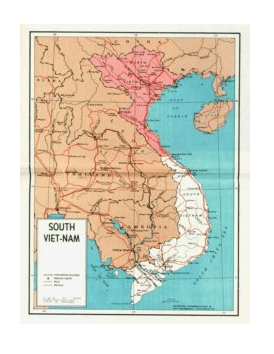
When we read history, we come across different terms that mix names of countries and regions. Some examples are ‘South- East Asia’, ‘South Asia’, ‘Tibeto- Burman’, etc. Similarly, ‘Indo- China’ was a collective term for Laos, Vietnam and Cambodia together. How do you think each of these countries carved out a separate identity for them-selves?
We shall see how Vietnam was emerging from the shadows of China. This was mainly led by the French colonial rule. However, anti-colonial feelings helped strengthen nationalism in later phases.
As mentioned earlier, Vietnam was just a surrounding area of China, that followed the same governance system and cultures. It was also a part of the rich silk trade route that exchanged people, goods and ideas. This started to change after they became a colony of the French.European Conquests
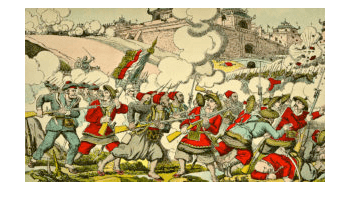
In medieval ages, Europeans embarked upon a quest to make colonies out of Asian countries. The reason they gave for this was the infamous ‘white man’s burden’ theory. It stated that Europeans were the most civilised and thus had a ‘duty’ to civilise the rest of the world.
But in reality, Europeans wanted a place where they could buy cheap raw material from and a market to sell goods. This system was extremely exploitative and created the division between the ‘developed’ and ‘underdeveloped’ countries.
Vietnam as a Colony
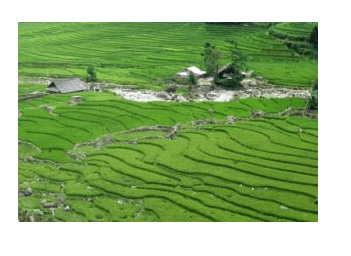
Like the British did in 1757 in India, the French too established their colony in Vietnam from 1858- 1880. After the Franco- China war, the French gained control of Tonkin and Anaam. Thereafter, they created a firm grip over the country, creating dissatisfaction among the masses, that led to the rise of nationalism.
At first, the French aimed at giving agriculture a boost. They made many canal networks and also reclaimed marshy lands for cultivation. The area of rice cultivation rose from 274000 hectares to 2.2 million hectares in 1930. By 1931, Vietnam had become the third largest producer of rice in the world. Two- thirds of this was exported and all the profits were reaped by the French.
Even infrastructure was added to help build the mass production in Vietnam. Railway networks were laid for the easy transportation of good and people. Railways linked the north and south of Vietnam to Yunan in China as well as Siam (Thailand).Vietnamese people worked as bonded labor to build these infrastructures. They suffered wide human rights violation and were badly exploited for the sake of profits.
Why did the French try to develop Vietnam?
You may think, why did the French spend money and effort in a place where they had no interest? Building the economy of Vietnam would make the people richer and thus, they could buy more goods from the French. This would ultimately benefit the French. Thehuge population, lack of land resources, etc., are problems in developing Vietnam.
This article gives the backdrop to the rise of nationalism in Vietnam (Indo- China). We have seen how Vietnam was a country that was just emerging from the shadows of China. It then became a colony for the French and that set the stage for the rise of nationalism. All the exploitative policies of the French thus united the Vietnamese with a spirit of nationalism.